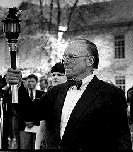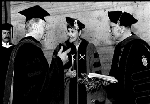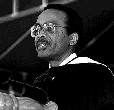
"A place so good as this"
The colorful Inauguration of William M. Chace celebrates Emory's history,
tradition, and promise
By John D. Thomas
- Click here to read about the special music commissioned for the Inauguration.
- Click here to read about the Habitat for Humanity project sponsored by Emory in honor of the Inauguration.
- Click here to read the full text of President Chace's inaugural address.
"Let everyone have a place amid this bounty."
--Emory University President William M. Chace,
from his inaugural address, April 5, 1995
On a clear, warm, spring day, some two thousand people--faculty, alumni,
students, staff, friends of the University, bishops of the United Methodist
Church, University trustees, and more than three hundred and fifty
representatives of academic institutions and learned societies--convened on the
Quadrangle for the Inauguration of William M. Chace as the eighteenth president
of Emory University. As the presidential fanfare commissioned for the event
faded into the afternoon, Dr. Chace approached the podium to
address the crowd, seated in the shadow of the Pitts Theology Library, the
first academic building constructed on the Atlanta campus.
"We can, all of us, do better," Dr. Chace said, challenging his audience. "And,
since we are at Emory, I can think of no more appropriate place for us to start
thinking about ways to accumulate even greater amounts of social capital than
that already given to us and earned by us. What shall we do here to arrest a
movement that could lead us into social and personal isolation? What can our
deep spiritual foundations do to help us avoid a withdrawal inward and lead us
out to a collective progress forward? What, on the campus--in this time and
place--can we do to pool our magnificent resources, and, by pooling them,
multiply them?"
 Even though that challenge was issued at the Inauguration of Emory's eighteenth
president, Dr. Chace's was only the fourth formal inauguration the University
has conducted. According to the December 1957 issue of the Emory
Alumnus, "When Goodrich C. White was inaugurated in the fall of 1942, World
War II was in progress and the program for that reason was kept simple. Dr.
White's predecessor--Dr. Harvey W. Cox,
the first president of the University--came to Emory in 1920, when the
institution was a group of loosely connected schools and colleges, and he did
not have a formal inauguration." Sidney Walter Martin, Emory's fifteenth
president, was given the first formal inauguration in November 1957.
Even though that challenge was issued at the Inauguration of Emory's eighteenth
president, Dr. Chace's was only the fourth formal inauguration the University
has conducted. According to the December 1957 issue of the Emory
Alumnus, "When Goodrich C. White was inaugurated in the fall of 1942, World
War II was in progress and the program for that reason was kept simple. Dr.
White's predecessor--Dr. Harvey W. Cox,
the first president of the University--came to Emory in 1920, when the
institution was a group of loosely connected schools and colleges, and he did
not have a formal inauguration." Sidney Walter Martin, Emory's fifteenth
president, was given the first formal inauguration in November 1957.
To honor Emory's heritage and the twelve Emory presidents who preceded Harvey
Cox, Dr. Chace's Inauguration began at Oxford College two days before the
Atlanta ceremonies. "In anticipation of the Inauguration of the eighteenth
president of Emory University, we gather at the site of its founding, at the
foot of the monument to its founder, Emory College's first president, Ignatius
Alphonso Few," Secretary of the University Gary Hauk '91G said, opening the
ceremony. "We draw upon the wellspring of history and traditions that he and
others set to flowing. Like a fountain emanating from a single source, the
University, represented by its various units, finds its strength in a common
mission. Here, in 1836, Emory College was founded. Responding to a fundamental
calling to serve the next generation, pioneers established what has grown into
a great University."
Dr. Chace was then escorted around the University's original campus by several
Oxford students, one of whom led the procession bearing the University torch.
At four stops, he and the assembled guests heard presentations on the different
missions of the University. At Phi Gamma Hall the topic was "Our Call to Heal";
at the Day Chapel, "Our Call to Serve God and Each Other Faithfully"; at
Hopkins Hall, "Our Call to Seek Truth and Knowledge"; and at Seney Hall, "Our
Call to Teach."
"Every school within a university teaches," said Stephanie Johnson, the student
reader at Seney Hall. "Graduates of these schools remember the greatest of
these knowledgeable caregivers who profoundly influence countless lives. When
George Seney, a New York banker, responded to his reading of the New South
sermon, he did so by honoring a relatively new college with a charitable gift,
part of which was used to construct this hall. The Victorian Gothic structure
still houses classrooms and faculty offices. Like a teacher, he shared what he
had, investing in a new generation. Mr. Seney died with little of his wealth.
Near his death he remembered his philanthropy with these words: `All I have is
what I have given away.' "
Following those presentations, Dr. Chace was presented with a pen set that had
been crafted by Oxford College Pierce Professor of Religion Hoyt Oliver. As a
tangible reminder of Emory's links to Oxford College, the gift was made of wood
collected from all over Oxford. "The pens are from walnut that came from the
bannister of Seney Hall. . . ," said Dean of Oxford College William H. Murdy in
presenting the gift. "The holder is set on a piece of shale that came from the
original roof of the bell tower in Seney Hall. The holder itself is heart pine,
which came from the shelves of Candler Library. The lamp of knowledge is cedar
from the President's home, and the yellow flame is osage orange from Florida
Hall, where students boarded for many years. Please keep this gift as a
reminder of Emory's rich heritage and Oxford College."
After a gala Inaugural concert on Tuesday evening that featured performances by
the University Chorus, the Emory Wind Ensemble, and the Emory Jazz Ensemble,
the actual Inauguration began Wednesday afternoon. At about 2:30, a long line
of Emory faculty, bishops of the United Methodist Church, student leaders,
trustees, and representatives of academic institutions, all colorfully clad in
academic regalia,
began filing into the Quadrangle.
When all were seated, Chief Marshal of the University John Manning opened the
proceedings with two raps of the gavel that then-President Warren A. Candler
had used a century ago. After an invocation from University Chaplain Susan
Henry-Crowe and a welcome from Chair of the Board of Trustees Bradley Currey
Jr., Dr. Chace received a series of greetings from President of the Atlanta
City Council and Emory Trustee Marvin S. Arrington Sr. '67L, on behalf of
Atlanta; DeKalb County Chief Executive Liane Levetan, on behalf of the people
of DeKalb County; Bishop of the United Methodist Church and Vice Chair of the
Board of Trustees L. Bevel Jones III '46C-'49T, on behalf of the Church;
Association of Emory Alumni President W. Shain Schley '62C-'66M, on behalf of
alumni; President of the Employee Council Kay Pendleton, on behalf of the
staff; past President of the Student Government Association Eddie Lee Irions
'95C, on behalf of students; President of the University Senate Luther E.
Smith, on behalf of the faculty; former President of Stanford University Donald
Kennedy, on behalf of higher learning; and former President of the United
States and University Distinguished Professor Jimmy Carter, on behalf of "the
world in need of fruitful scholarship."
 "Mr. President, we anticipate your leadership in helping us think otherwise
about any aspect of our work that betrays truth and diminishes excellence in
the pursuit of truth," Associate Professor of Theology Luther E. Smith said
during his greeting. "We welcome you as a faculty colleague. You are a noted
scholar of whom we are proud. We welcome you as our president. Your excitement
about Emory's mission and the role of all members of this community for the
fulfillment of that mission reassures and inspires us. May our work together
honor the tradition and promise that is Emory University."
"Mr. President, we anticipate your leadership in helping us think otherwise
about any aspect of our work that betrays truth and diminishes excellence in
the pursuit of truth," Associate Professor of Theology Luther E. Smith said
during his greeting. "We welcome you as a faculty colleague. You are a noted
scholar of whom we are proud. We welcome you as our president. Your excitement
about Emory's mission and the role of all members of this community for the
fulfillment of that mission reassures and inspires us. May our work together
honor the tradition and promise that is Emory University."
During the investiture of the president that followed, Dr. Chace was presented
with a series of symbolic gifts representing the University's heritage: Emory's
original hand-written charter from 1836; the presidential medallion; keys to
several buildings, including Oxford's Phi Gamma Hall (Emory's oldest campus
building), Pitts Theology Library, Lullwater House, and Glenn Memorial Church;
and a sprig of holly from a tree under which Methodist Church founder John
Wesley had preached while a Georgia missionary and which was brought to the
University from near Savannah around 1920.
After receiving those historic symbols, Dr. Chace approached the lectern to
deliver his inaugural address. His thirty-five-minute speech touched on
numerous topics, including the importance of uniting good teaching and
research, the creation of a president's commission on equity, and the need for
a center for the performing arts. However, Dr. Chace said the University's most
important responsibility was "to prize and to sustain a life of the mind that,
on this campus, will draw students closer to each other, students and teachers
into more powerful associations, and the faculty into a more energetic and
enterprising union of intellectual pioneers.
"We know the essential truth about any place so good as this. It thrives or
perishes by how strong its thinking is. That thinking becomes visible in the
research we generate and give to the world and the teaching we perfect and
extend to our students. At the end of all our labors, when the reckoning is
done, let it be said of the people of Emory that they dedicated themselves to
the creation of thought and that they combined their resources, through the
great engine of their own remarkable social capital, to making mind
prevail, to making thinking prevail, to making discovery
prevail."
Following Dr. Chace's address, Thomas Thangaraj, associate professor of world
Christianity in the Candler School of Theology, delivered the benediction. "Let
us step into the future with confidence and hope," he said. "May our pursuit of
excellence be always complemented by our desire to care for each other. May our
search for the truth be always accompanied by our appreciation of plurality and
variety."

 As the recessional began, the Indigo Girls, Grammy-award-winning Emory alumnae
Amy Ray '86C and Emily Saliers '85C, could be heard warming up for a
post-inaugural concert. Soon, thousands would gather on McDonough Field to
listen and to celebrate the Inauguration of Emory's eighteenth president.
As the recessional began, the Indigo Girls, Grammy-award-winning Emory alumnae
Amy Ray '86C and Emily Saliers '85C, could be heard warming up for a
post-inaugural concert. Soon, thousands would gather on McDonough Field to
listen and to celebrate the Inauguration of Emory's eighteenth president.
Click here to return to Summer 1995 contents page.
Click here to return to Emory University Home Page.
 Even though that challenge was issued at the Inauguration of Emory's eighteenth
president, Dr. Chace's was only the fourth formal inauguration the University
has conducted. According to the December 1957 issue of the Emory
Alumnus, "When Goodrich C. White was inaugurated in the fall of 1942, World
War II was in progress and the program for that reason was kept simple. Dr.
White's predecessor--Dr. Harvey W. Cox,
the first president of the University--came to Emory in 1920, when the
institution was a group of loosely connected schools and colleges, and he did
not have a formal inauguration." Sidney Walter Martin, Emory's fifteenth
president, was given the first formal inauguration in November 1957.
Even though that challenge was issued at the Inauguration of Emory's eighteenth
president, Dr. Chace's was only the fourth formal inauguration the University
has conducted. According to the December 1957 issue of the Emory
Alumnus, "When Goodrich C. White was inaugurated in the fall of 1942, World
War II was in progress and the program for that reason was kept simple. Dr.
White's predecessor--Dr. Harvey W. Cox,
the first president of the University--came to Emory in 1920, when the
institution was a group of loosely connected schools and colleges, and he did
not have a formal inauguration." Sidney Walter Martin, Emory's fifteenth
president, was given the first formal inauguration in November 1957.


